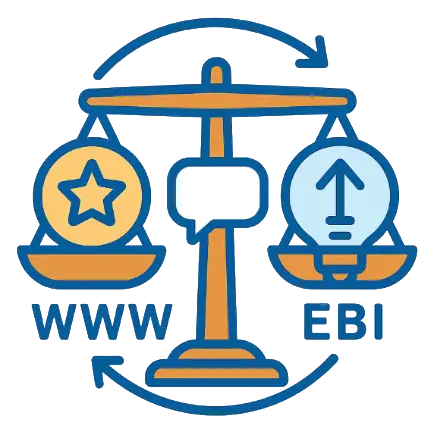How to Give Balanced (Strengths and Weaknesses) 360 Feedback
We all recognise the importance of giving balanced 360 feedback, celebrating what has gone well while also exploring opportunities for growth. Yet achieving that balance in written comments is often difficult. Positive points are easily overshadowed by what follows, and so-called “negative” aspects, however carefully phrased, can still come across as criticism. Words like developmental, constructive, or critical often sound harsh and judgemental, even when the intention is to help.
People are also more sensitive to criticism than praise, a negativity bias that means negative comments linger far longer people’s in memory. The familiar “feedback sandwich” (praise, criticism, praise) is often seen as formulaic and insincere, especially in written feedback where tone is harder to interpret.
And because many people worry about how their words will be received or fear damaging relationships, they soften or avoid honest feedback altogether. As a result, comments intended to support development can end up vague, diluted, or too cautious to have real impact.

A Better Approach: What Went Well (WWW) and Even Better If (EBI)
This is where the WWW and EBI framework offers a powerful alternative approach. It helps you write 360 feedback comments that feel balanced, constructive and useful. Instead of focusing only on what needs to change, it encourages you to recognise strengths first and then explore how things could be improved without blame or negativity. It also has the following advantages:
- A more positive starting point: Beginning with What Went Well ensures that achievements, behaviours and decisions are acknowledged before any areas for improvement are raised. This recognition builds confidence, reinforces what should continue and makes people more open to the feedback that follows. In written comments, it also provides important context, helping the recipient understand what they are doing well and why it matters.
- Shifting from criticism to possibility: Even Better If is where the developmental element sits, but with a crucial difference: the phrase suggests potential rather than failure. Instead of highlighting mistakes, it helps you frame suggestions as opportunities to build on what is already working. Phrasing feedback as “It would be even better if…” keeps comments forward-focused, constructive and easier to act on, which makes them far more effective in a 360 feedback report.
Practical 360 Feedback Strengths and Weaknesses Examples
When completing a 360 feedback questionnaire, writing comments that are both constructive and actionable can be challenging. The examples below show how to structure feedback using the WWW (What Went Well) and EBI (Even Better If) approach. Each one illustrates how to provide clear, balanced comments on 360 feedback strengths and weaknesses — the kind of feedback that supports meaningful development and is highly valued in 360 reports.
Example 1: Generating ideas
- Traditional comment: “Has lots of ideas but doesn’t listen to anyone else.”
- WWW and EBI comment: “They bring lots of creative ideas and are proactive about suggesting ways to improve how we work. It would be even better if they also took more time to listen to and build on the ideas of others.”
Example 2: Communication style
- Traditional comment: “Can be unclear when explaining things.”
- WWW and EBI comment: “They share information openly and keep the team updated. It would be even better if they provided more context and examples when explaining complex points.”
Example 3: Leadership approach
- Traditional comment: “Needs to trust the team more.”
- WWW and EBI comment: “They are highly committed and take responsibility for outcomes. A build on this would be to delegate more and give others space to make decisions.”
These examples show how small changes in phrasing can make feedback more balanced and useful. By clearly identifying strengths and pairing them with specific suggestions for improvement, you create 360 feedback strengths and weaknesses comments that are more likely to be heard, understood and acted upon.
The Value of Balance in 360 Feedback
Ultimately, delivering balanced 360 feedback on strengths and weaknesses is about more than simply being polite. It is about making feedback meaningful and actionable. By celebrating what is already working and framing improvements as opportunities rather than failures, the WWW and EBI approach transforms feedback from something people dread into something they value. It builds trust, encourages growth and turns feedback into a powerful driver of learning and development.
FAQs on How to Give Balanced (Strengths and Weaknesses) 360 Feedback
Q. How do you give constructive feedback in a 360 review?
A. Constructive feedback in a 360 review should be specific, actionable and supportive. Start by highlighting achievements and behaviours that have gone well, then suggest clear ways to improve. Using the What Went Well (WWW) and Even Better If (EBI) approach keeps feedback practical, focused and easier to act on.
Q. How do you give balanced (strengths and weaknesses) 360 feedback?
A. Balanced 360 feedback highlights both strengths and areas for growth. Recognise what the person does well, then frame development points as opportunities to build on those strengths. The WWW and EBI approach keeps comments constructive and meaningful, helping people understand how to sustain success and improve further.

